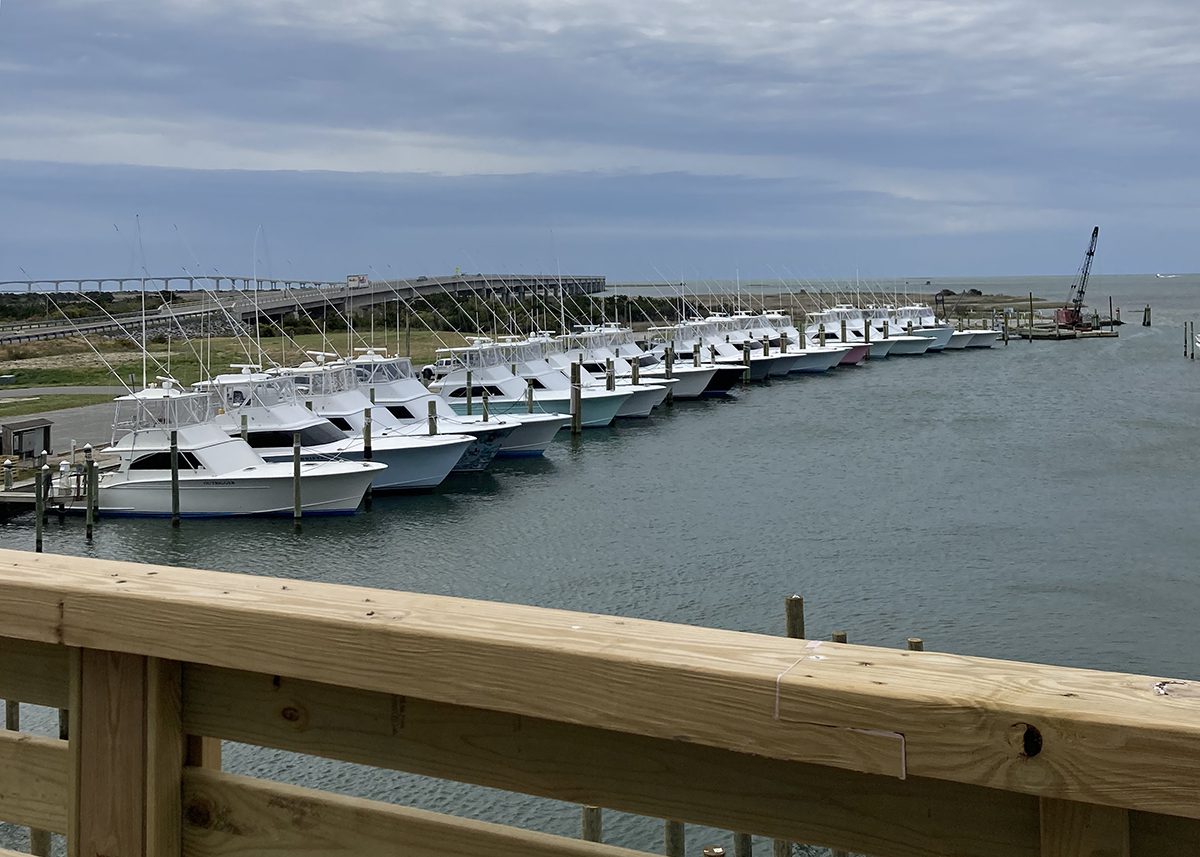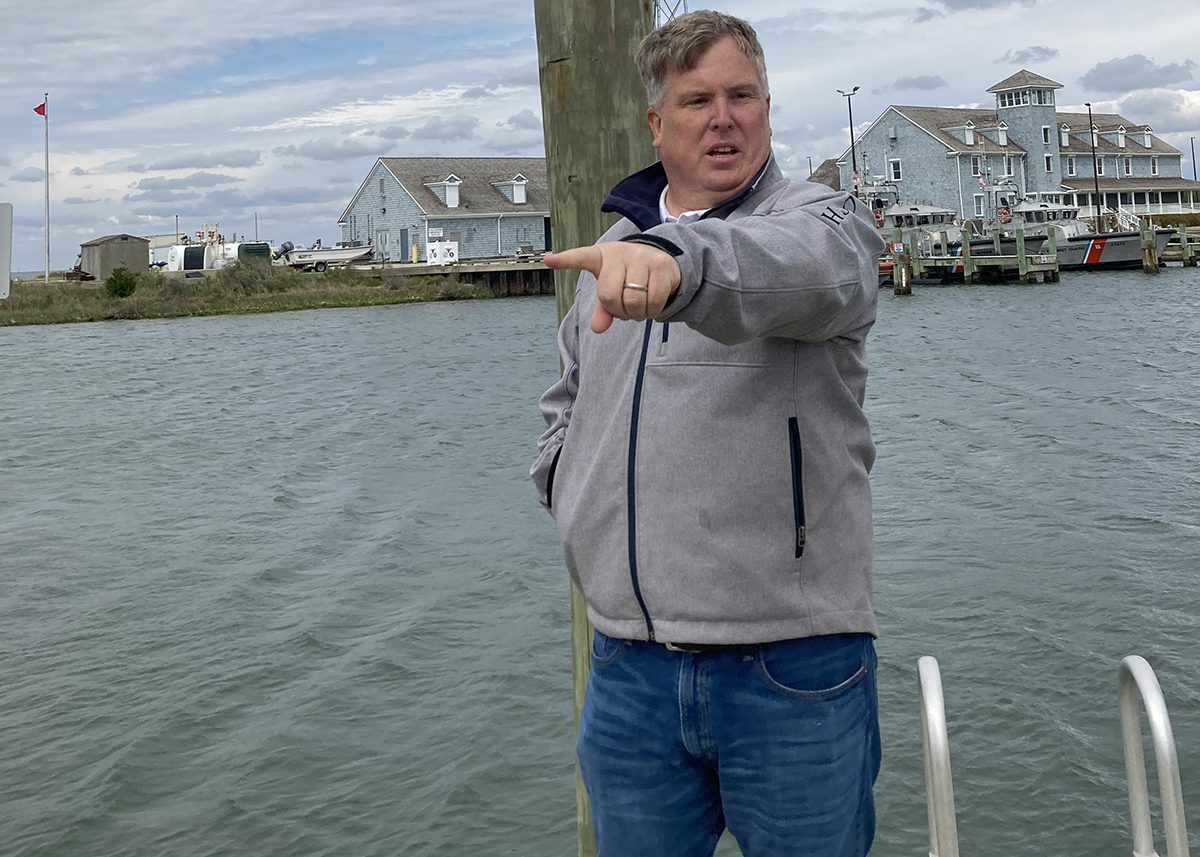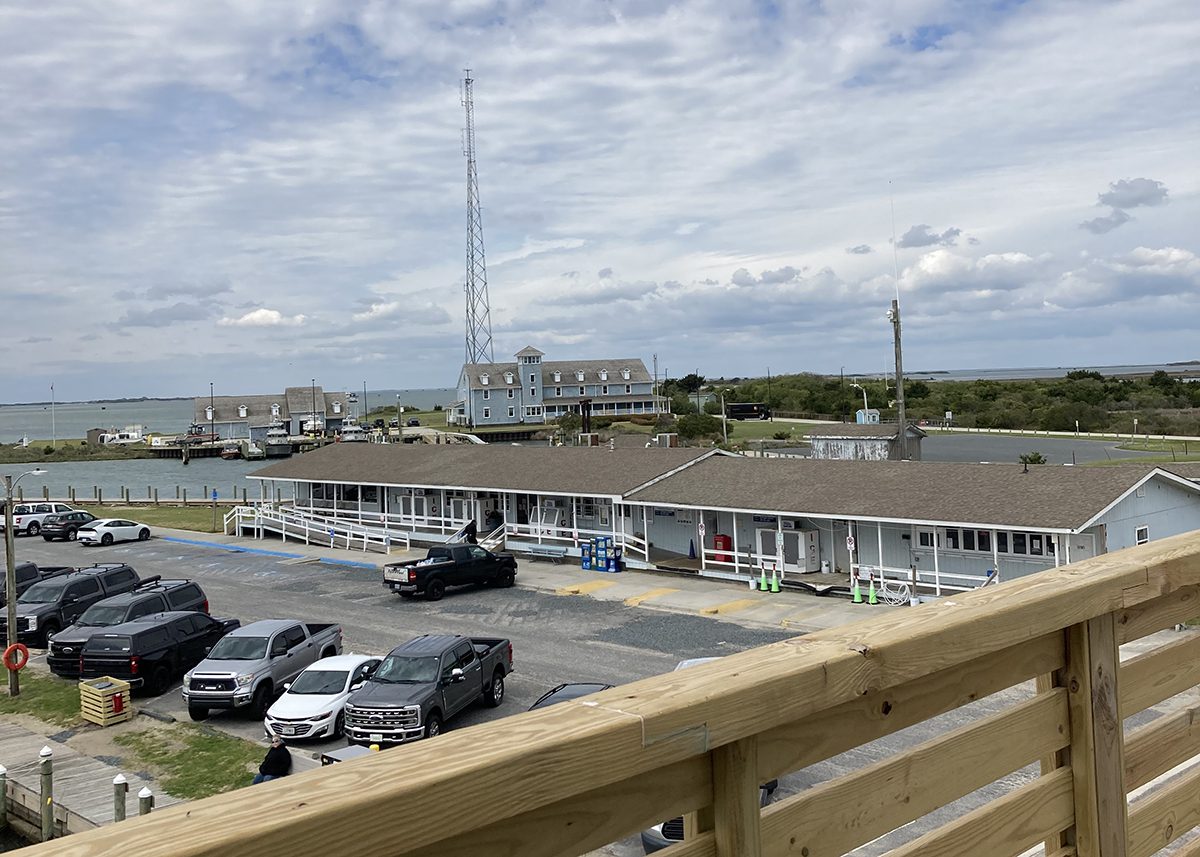
NAGS HEAD — What was lacking in Oregon Inlet Fishing Center’s unadorned functionality was made up for in its singular location at the edge of Outer Banks’ premier fishing grounds.
For decades, fishers, campers and folks just watching the fleet come back through the ocean bar after a day offshore stopped at the marina on the northwest side of the inlet, which provides passage between the Pamlico Sound to the Atlantic under the high span of the Basnight Bridge.
Supporter Spotlight
Now, the 70-year-old fishing center’s retail tackle shop and charter reservation business will relocate to a new, two-story, climate-resilient building that is elevated 11 feet above ground and topped by a metal roof that can withstand 150 mph winds. Inside, a restaurant run by award-winning chefs and a full retail area on the first floor, and offices and an event room with a deck on the second floor.
“At the end of the day here, we have the best charter fleet up and down the East Coast, if not the country,” Russ King, managing operator of Oregon Inlet Fishing Marina LLC, said before a ceremonial ribbon-cutting Monday morning. “And we now are going to have facilities that match. So, with that, we’re really hoping to make a true destination for the family, for the customer experience, for people coming to the national seashore.”
For the majority of the time the 1950s fishing center has been at Oregon Inlet, it was operated by a group of stockholders that was originally 22 of the who’s who of famed Outer Banks’ fishing boat captains, including Omie Tillett, Billy Brown, Warren O’Neal, Buddy Canady, Lee Perry, Arvin Midgett, Rudolph Peele and Tony Tillett.
In earlier days, the captains had moored in a ditch near the current Pirate’s Cove Marina before establishing a small outpost at the Oregon Inlet location. After Cape Hatteras National Seashore, which encompasses the Oregon Inlet area, was established in 1953, the Oregon Inlet Fishing Center, LLC, partners operated the marina under a concession agreement with the National Park Service.
But the partnership, stressed by changes over the decades, eventually failed to reach terms to renew the agreement with the park service. In December 2018, the agency announced that it had executed a lease with Oregon Inlet Marinas, LLC to operate and maintain the fishing center.
Supporter Spotlight
In an open letter after the announcement, Capt. Kenneth Brown, president of Oregon Inlet Fishing Center Inc., recalled the joy the center provided to the many visitors who came to see the catch of the day or admire the custom vessels at the docks.
“Regardless of the reason, Oregon Inlet Fishing Center has offered family and friends the opportunity to spend time together and make lasting memories,” the letter said. “We have seen our customers return year after year and measure success in their patronage. For that we say thank you.”
At the time of the transfer, according to a park service press release, Oregon Inlet Fishing Center was comprised of a 60-slip marina, seven buildings totaling 7,369 square feet, around 7.4 acres of land, a parking lot with about 220 spaces, six vessel fuel pumps, one vehicle fuel pump, and associated fuel system and storage. A public boat ramp and the parking lot were managed by the park service.
The center’s annual gross receipts were $3.38 million in 2014, $3 million in 2015, and $2.93 million in 2016, according to the park service.
“The Oregon Inlet Fishing Center and the talented captains docking at the marina have put Oregon Inlet on the map as one of the best offshore fishing destinations in the world,” David Hallac, superintendent of National Parks of Eastern North Carolina, said in the statement.
The park service’s request for proposals required the lessee, managed by Russell King, to create “a safe, sustainable, environmentally sound and resilient marina bulkhead” for operations.

According to terms of the 20-year lease, the company will pay 5% of gross receipts and an annual fixed fee of $40,000 to the park service.
In turn, Oregon Inlet Marinas would be authorized to continue the fishing center operations, including renting slips to charter fishing vessels, headboats, tour boats and dive boats, as well as large commercial and government vessels. Sales of food and alcoholic and nonalcoholic beverages, and special events associated with the use of the marina are also permitted.
Replacement of the bulkheads along the 1,700-linear-foot marina began in 2019, King said in a media tour before the ribbon-cutting. The marina, which is expected to open in early May, will offer in-slip fueling with nonethanol gas or diesel at the 60 slips, and a reinforced 17-foot bulkhead.
A 60-foot-long test section of the boardwalk is made of Titan decking, a resilient composite material that allows drainage. A 90-foot-long transient dock, which along with a dock walkway, is built with marine treated wood and reinforced with multiple pilings to protect the marina from vessel strikes.
““This dock is not going anywhere,” King said. “What we wanted to do was create a more safe experience for the charter boats.”
In addition, the park service will replace the asphalt in the parking lot and add improved stormwater drainage.
Construction of the nearly 10,000-square-foot building started in June 2022 where the original center had once stood, before it was severely damaged by the infamous Ash Wednesday Storm in 1962.
The old building was renovated by the new operators so customers could still be served in the interim. That building, which was expanded at its current site across from the U.S. Coast Guard Station, will be demolished and an open-air pavilion, owned by the King family, will be installed.

The new fishing center, designed by Beacon Architects of Kill Devil Hills, is notably more expansive than the modest former fishing center. On the 5,600 square-foot first floor, there’s a retail store, operated by Oceans East Bait and Tackle, a dedicated charter reservation area and a restaurant that offers counter service and provides takeout food and “tackle box” meals.
The restaurant, Sea Chef Dockside Kitchen is already open, serving its all-day menu from 11 a.m. to 8 p.m. six days a week, said Mac Buben, half of the father-son chef team running the eatery.
Jeff Buben, a 45-year veteran of the restaurant business, is an award-winning chef who worked in New York City and Washington, D.C., restaurants before moving last year to the Outer Banks.
His son, Mac Buben, who most recently worked at Blue Point restaurant in Duck, said the building will be open early for pre-dawn fishing trip departures, when “tackle box” breakfasts and sandwiches will be available.
Hours of operation, he said, will be adjusted and expanded as time goes on.
“It’s a soft landing, if you will,” Buben said.
On the 4,000-square-foot second floor, along with administrative offices, there is a conference/event room with a capacity of 50, that opens to a large open-air deck.
“And what I consider the best view on the Outer Banks,” King added, as he stepped outside and pointed to each part of the panoramic view. “You see the ocean here, you see the sound here, you see the lighthouse right here.”
And soon, visitors will be seeing many a glorious sunrise and sunset from those decks.







